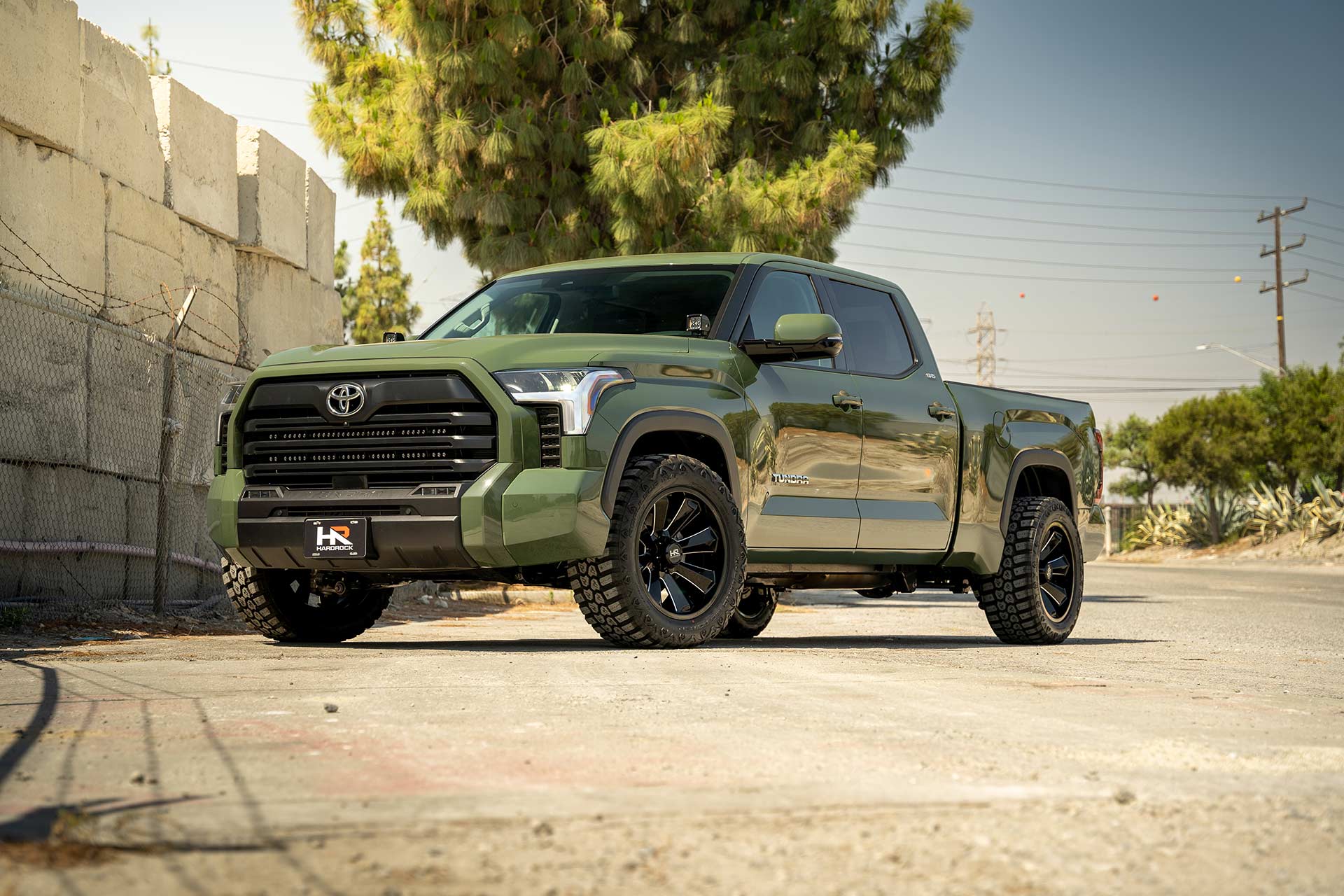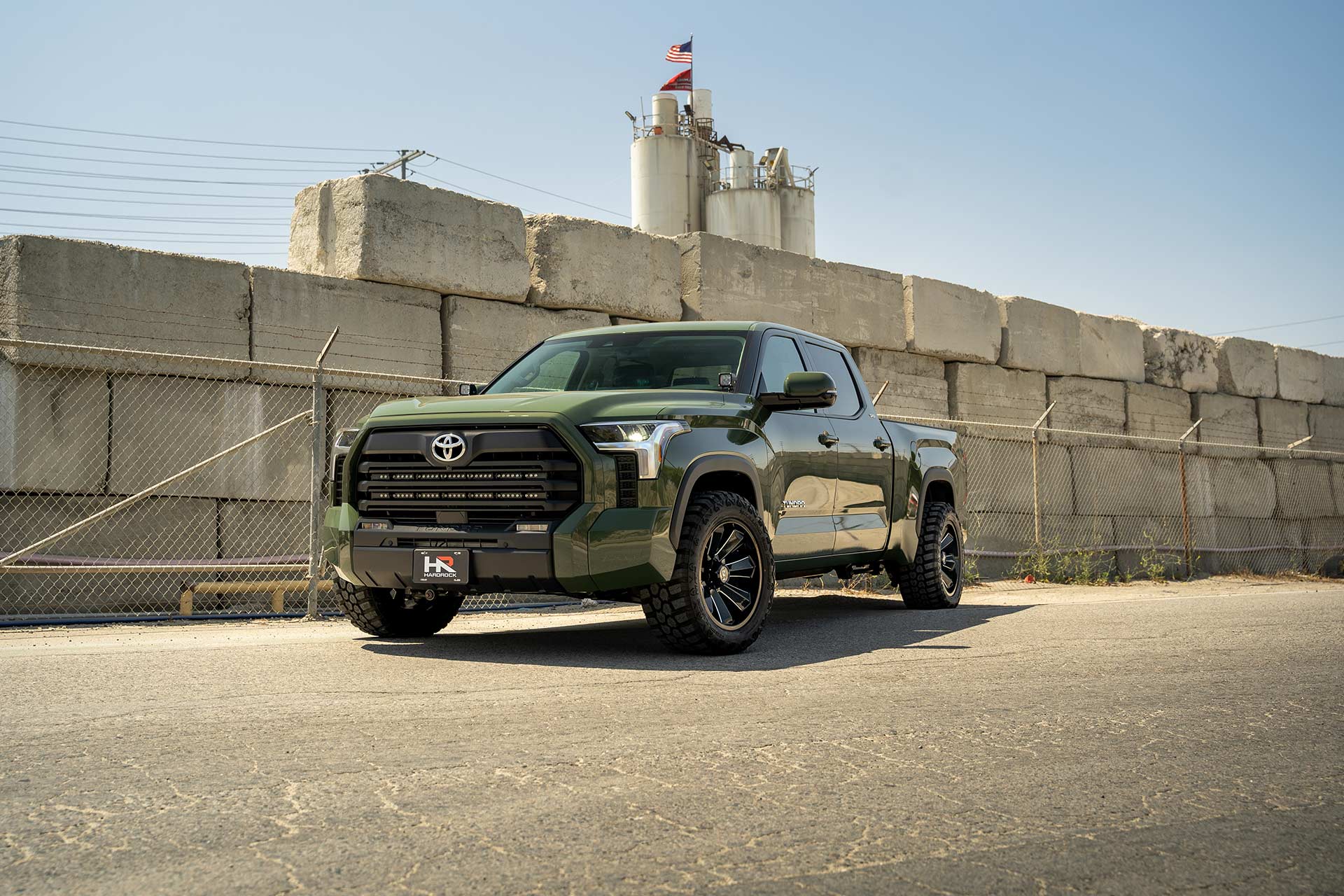
Toyota Tundra Wheel Fitment Guide
The Toyota Tundra has defined the full-size pickup segment since its debut, earning a reputation for uncompromising strength, reliability, and versatility. Whether tackling tough jobs, hauling heavy loads, or venturing off the beaten path, the Tundra’s robust platform and enduring V8 power have made it a favorite among truck enthusiasts and overland adventurers alike. For many Tundra owners, upgrading wheels and tires is a top priority—unlocking greater off-road capability, sharper handling, and a bold, personalized look.
From the work-ready SR to the trail-dominating TRD Pro, each Tundra trim offers unique wheel and tire setups tailored to its mission. Yet, for those seeking to push their truck’s limits, moving to more aggressive truck wheels can can dramatically enhance both performance and curb appeal.
In this comprehensive fitment guide, we’ll break down the extensive research and real-world testing performed by Hardrock Offroad to ensure your Tundra receives wheels engineered for both rugged style and genuine utility. Whether you’re keeping a refined OEM+ stance on stock suspension or planning a lifted, trail-conquering build, this guide will help you select the perfect wheel and tire combination for your Toyota Tundra—ensuring every mile is as capable as it is commanding.
OEM Toyota Tundra Wheel & Tire Fitment
| Generation | Wheel Size & Offset | Tire Size | Bolt Pattern | Bore |
|---|---|---|---|---|
| XK50 (2007-2009) | 17×8 +50 | 285/70R17 | 5×150 | 110.1mm |
| XK50 (2007-2009) | 18×8 +60 | 255/70R18 | 5×150 | 110.1mm |
| XK50 (2007-2009) | 18×8 +60 | 275/65R18 | 5×150 | 110.1mm |
| XK50 (2007-2009) | 20×8 +60 | 275/55R20 | 5×150 | 110.1mm |
| XK50 Facelift (2010-2013) | 17×8 +50 | 285/70R17 | 5×150 | 110.1mm |
| XK50 Facelift (2010-2013) | 18×8 +60 | 255/70R18 | 5×150 | 110.1mm |
| XK50 Facelift (2010-2013) | 18×8 +60 | 275/65R18 | 5×150 | 110.1mm |
| XK50 Facelift (2010-2013) | 20×8 +60 | 275/55R20 | 5×150 | 110.1mm |
| XK50 Facelift (2014-2022) | 18×8 +60 | 255/70R18 | 5×150 | 110.1mm |
| XK50 Facelift (2014-2022) | 18×8 +60 | 275/65R18 | 5×150 | 110.1mm |
| XK50 Facelift (2014-2022) | 20×8 +60 | 275/55R20 | 5×150 | 110.1mm |
| XK70 (2022-2026) | 18×7.5 +60 | 265/70R18 | 6×139.7 | 95.2mm |
| XK70 (2022-2026) | 18×7.5 +60 | 245/75R18 | 6×139.7 | 95.2mm |
| XK70 (2022-2026) | 18×8.5 +47.5 | 285/65R18 | 6×139.7 | 95.2mm |
| XK70 (2022-2026) | 20×8 +60 | 265/60R20 | 6×139.7 | 95.2mm |
| XK70 (2022-2026) | 20×8.5 +55 | 265/65R20 | 6×139.7 | 95.2mm |
| XK70 (2022-2026) | 22×8 +60 | 265/50R22 | 6×139.7 | 95.2mm |
Popular Toyota Tundra Wheels
Understanding Offset & Backspacing
Wheel offset is a number, either positive or negative, that determines the distance between the wheel’s center-line and the mounting surface or back pad of the wheel. There are a lot of variables in choosing the right offset for your Tundra; such as clearance. When you’re mounting an aftermarket wheel, you want to ensure that the wheel isn’t rubbing or scrubbing against the fender, fender liner or any part of the suspension when at full lock to either side or when in the neutral position.
In short, there are three different offsets: positive, zero and negative. Positive offset is when the wheel is sitting closer to the suspension, zero is dead center, and negative offset is when the wheel is further away from the suspension.
Toyota Tundra Wheels: Fitments
Below you’ll see a list of available Toyota Tundra wheel fitments from Hardrock Offroad, from 2007-2026. Note that starting in 2022, bolt pattern and bore have changed from the original 5×150 and 110.1mm respectively. It’s also important to consider that to fit some of these wheels, you will either need a suspension lift or trimming/modifying of fenders, fender liners or in extreme cases, bumpers. In general a stock Tundra suspension can accommodate 17×9, 20×10, 22×10 and 22×12 with little to no rubbing and required modifications.
| Wheel Model | Wheel Size & Offset | Tire Size (Standard/Flotation) |
|---|---|---|
| H105, H106, H107, H108, H109, H110, H111 | 17×9 +1 | 265/70R17 (31.6″ x 10.4″) 275/70R17 (32.1″ x 10.8″) 285/70R17 (32.7″ x 11.2″) |
| H105, H106, H107, H108, H109, H110, H111 | 17×9 -12 | 285/70R17 (32.7″ x 11.2″) 285/75R17 (33″ x 11.2″) 33×11.5R17 |
| H105, H107, H108, H109, H110, H111 | 20×10 -19 | 305/55R20 (33″ x 12″) 295/60R20 (33.4″ x 11.6″) 33×12.5R20 |
| H500 | 22×12 -44 | 325/50R22 (35.7″ x 12.8″) 35×12.5R22 |
| H502, H504 | 20×9 +0 | 275/60R20 (33″ x 10.8″) 285/55R20 (32.1″ x 11.2″) 305/55R20 (33″ x 12″) |
| H502, H503, H504, H505, H506, H507, H508, H509 | 20×10 -19 | 305/55R20 (33″ x 12″) 295/60R20 (33.4″ x 11.6″) 33×12.5R20 |
| H502, H503, H504, H505, H506, H507, H508, H509 | 20×12 -44 | 33×12.5R20 35×12.5R20 325/60R20 (35.5″ x 12.8″) |
| H502, H504 | 22×10 -25 | 305/45R22 (33″ x 12″) 33×12.5R22 |
| H503 | 20×12 -51 | 33×12.5R20 35×12.5R20 325/60R20 (35.5″ x 12.8″) |
| H700, H704, H705, H707, H708, H709 | 20×9 +0 | 275/60R20 (33″ x 10.8″) 285/55R20 (32.1″ x 11.2″) 305/55R20 (33″ x 12″) |
| H713, H714 | 20×9 +20 | 275/60R20 (33″ x 10.8″) 275/65R20 (34.1″ x 10.8″) |
| H700-H718 | 20×10 -19 | 305/55R20 (33″ x 12″) 295/60R20 (33.4″ x 11.6″) 33×12.5R20 |
| H700, H704, H705, H707, H708, H709 | 20×12 -44 | 33×12.5R20 35×12.5R20 325/60R20 (35.5″ x 12.8″) |
| H710, H711, H712, H713, H714 | 20×12 -51 | 33×12.5R20 35×12.5R20 325/60R20 (35.5″ x 12.8″) |
| H707, H708, H709, H711, H712, H713, H714 | 22×10 -25 | 305/40R22 (32.1″ x 12″) 305/45R22 (33″ x 12″) 33×12.5R22 |
| H709 | 22×10 -19 | 305/40R22 (32.1″ x 12″) 305/45R22 (33″ x 12″) 33×12.5R22 |
| H905, H906, H907, H908, H909, H910, H911, H912, H913 | 22×12 -51 | 325/50R22 (35.7″ x 12.8″) 35×12.5R22 |
Wheel Construction
In recent years, new types of wheel construction have been introduced into the off-road wheel market. In addition to offset, backspacing and aesthetic considerations, now you can choose what type of wheel construction you prefer. The most common type of wheels are cast wheels. As the name suggests, cast wheels are molded using molten aluminum. The next step up are flow formed wheels, which follow the same process as cast wheels, except the barrel has been spun, stretched and compressed to shape. Then there are forged wheels, which are completely machined from one block of aluminum. There are benefits and disadvantage to all three types of wheels, however most off-road trucks, Jeeps and SUVs utilize cast wheels.
Which Wheels Will Fit My Toyota Tundra?
Contact our Toyota Tundra wheel experts to see which diameter, width and offset best suit your needs
"*" indicates required fields
Frequently asked questions
What is the bolt pattern and hub bore size for my Toyota Tundra?
For the latest 2022 and newer Toyota Tundra, the bolt pattern is 6x139.7 mm (also known as 6x5.5 inches), and the center hub bore is 95 mm. If you have a 2007–2021 Tundra, you’re looking at a 5x150 mm bolt pattern with a center bore around 110 mm. Always check your specific year to confirm before ordering wheels, but if you stick with these specs, you’re set for a perfect Hardrock Offroad fit.
Can I run 17-inch wheels on my Tundra, or should I stick with 18s or 20s?
Absolutely, you can run 17-inch wheels on many Tundras, especially the 2007–2021 models, but it’s a tight fit around the front brake calipers. For 2022 and newer Tundras, not every 17-inch wheel will clear the larger brakes, so always make sure the wheel is verified to fit before you buy. Hardrock Offroad offers options designed to clear those calipers, so you can enjoy a beefier tire sidewall if that’s your style.
What’s the largest tire size I can fit on my Tundra without a lift?
On stock suspension, the sweet spot is a 33-inch tire. You can squeeze a bit more with the right offset, but 33s are the go-to for most Tundra owners who want a no-hassle fit with Hardrock Offroad wheels. Going bigger usually means you’ll run into rubbing issues unless you lift or trim some fender liner.
If I lift my Tundra, what wheel and tire sizes work best?
With a leveling kit (about 2–3 inches), you can comfortably run 33-inch or even 35-inch tires on wheels like 18x9 or 20x9 with the right offset. For a 6-inch lift, you can step up to 35s or even 37s, especially with an 18x9 or 20x10 wheel. Just remember, the more aggressive the wheel offset, the more trimming you might need for a clean, rub-free look.
Do I need to worry about offset and backspacing with aftermarket wheels?
Definitely. Offset and backspacing are key to getting the right stance and avoiding rubbing. A positive offset (like +18 or +20 mm) keeps your wheels tucked in, which helps with clearance. Go too low (or negative offset), and your wheels will poke out, which looks tough but can lead to rubbing on turns. Hardrock Offroad wheels are engineered with offsets that work great for Tundras, whether you want a subtle upgrade or a bold, aggressive look.
Can I use my stock lug nuts with Hardrock Offroad wheels?
No, you can’t. Toyota’s factory lug nuts are flat-seat style, while Hardrock Offroad wheels use a 60-degree conical seat. You’ll need to use the proper conical seat lug nuts for a safe and secure fit. Don’t worry—we can get you set up with exactly what you need for your new wheels.


